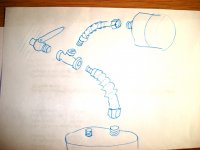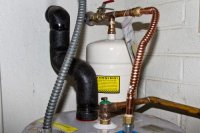go_hercules
Member
I need to install an expansion tank over an existing water heater in a pretty confined space. Regarding plumbing it in, the supply ball valve out of the wall has threads that connect to a corrugated copper hose (I believe a BrassCraft or the like). If I want to put a tee right off the ball valve, what threads would the tee have? I think they show the hoses as FIPS but is this the same as NPT? I would like to put the tee at the ball valve with the other two ports going to the heater and the tank with similar corrugated copper lines. (see next post, I added an image).
Last edited:


